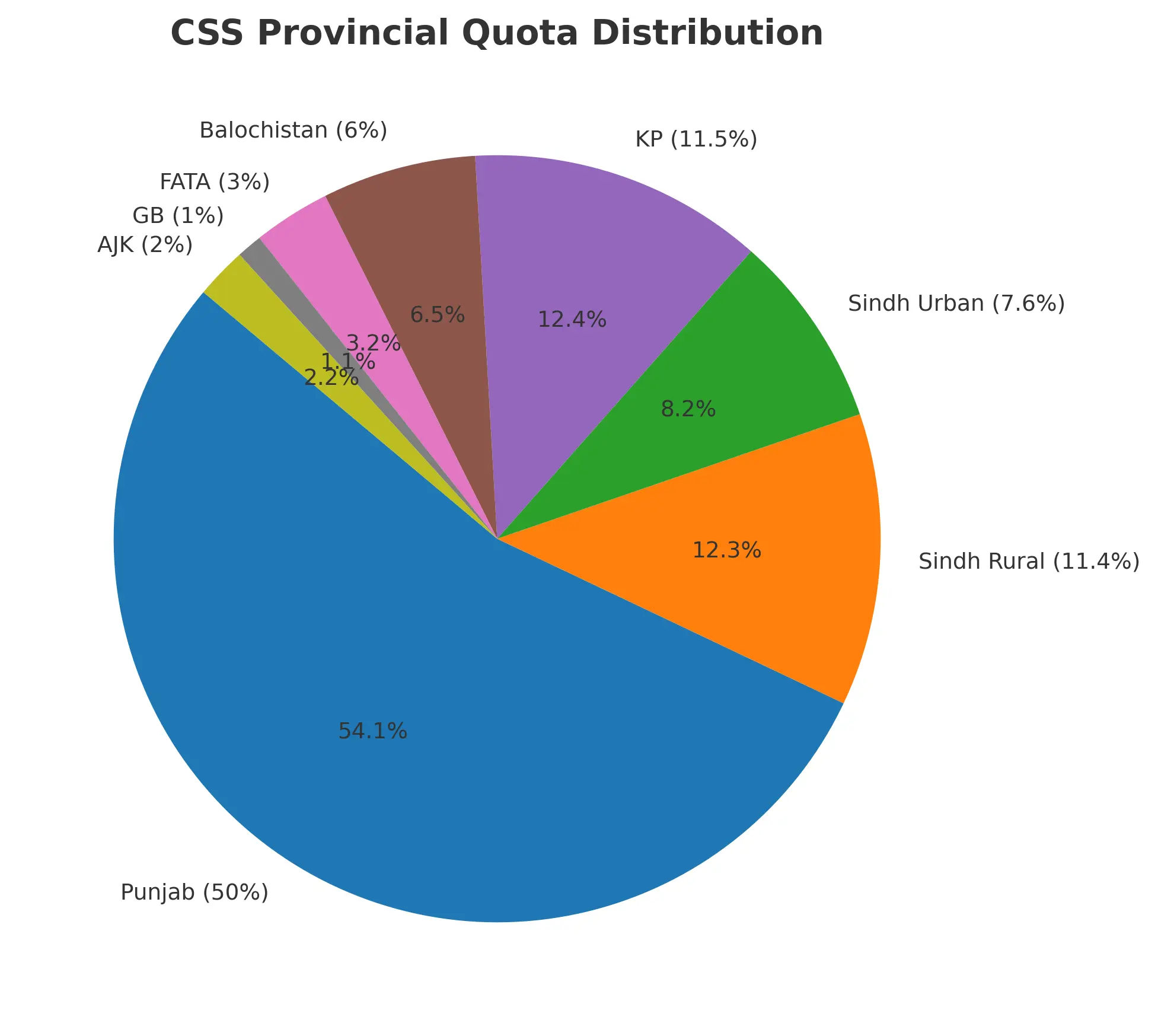Understanding Gender and Provincial Quota in CSS Exam 2026 – A Comprehensive Guide
Introduction
The CSS exam is the gateway to Pakistan’s civil services, but it’s not just about merit—quota systems also play a vital role in the allocation of seats. After the written exam, medical, psychological, and interview stages, candidates are assigned to different occupational groups based on merit and quota distribution. The quota system ensures that all regions and genders in Pakistan are fairly represented in civil services, allowing for equal opportunities regardless of location or background.
For aspirants, understanding the provincial and gender quotas is crucial in preparing for the CSS exam, as these factors significantly impact your final allocation.
Provincial Quota in CSS
According to the current rules of the Federal Public Service Commission (FPSC), CSS seats are divided across provinces and regions on the basis of population.
Here is the provincial quota distribution:
| Category | Percentage of Total CSS Posts |
|---|---|
| Merit (All Pakistan) | 7.5% |
| Punjab (incl. ICT) | 50% |
| Sindh – Urban | 7.6% |
| Sindh – Rural | 11.4% |
| Khyber Pakhtunkhwa | 11.5% |
| Balochistan | 6% |
| Gilgit-Baltistan & (former FATA) | 4% |
| Azad Jammu & Kashmir | 2% |
| Women (horizontal) | 10% (within each region’s share) |
| Minorities (horizontal) | 5% (within each region’s share) |
Key Points to Understand:
- Punjab has the largest share of seats (50%), reflecting its population size.
- Sindh is divided into Urban (7.6%) and Rural (11.4%) seats to address the disparity between urban and rural areas.
- Balochistan receives 6% of seats, which is crucial for ensuring the province is adequately represented in the federal services.
- Gilgit-Baltistan and former FATA also have a dedicated 4% quota.
Gender Quota in CSS
Although there is no separate CSS exam for men and women, the FPSC has introduced a 10% women’s quota across all regions to promote female participation in civil services. This quota ensures that women have equal opportunities to compete for civil service positions, even if they don’t secure seats purely on merit.
- If the female candidates do not secure seats based on their merit position, they are adjusted under the women’s quota.
- This quota system has significantly increased the representation of women in key positions in the Pakistan Administrative Service (PAS), Police Service of Pakistan (PSP), Foreign Service of Pakistan (FSP), and other groups.
Minority Quota in CSS
A 5% minority quota is also reserved for religious minorities (Christians, Hindus, Sikhs, Parsis, etc.) in CSS recruitment. This ensures that Pakistan’s civil services are diverse and representative of the country’s population.

How Allocation Works?
- Merit List – Candidates are first placed in a merit list based on their performance in the written exam and interviews.
- Provincial Quota – Seats are filled according to the provincial share, ensuring each province gets its allocated percentage of posts.
- Women & Minority Quota – If candidates from these groups don’t make it on open merit, they are placed under their respective quotas.
- Group Allocation – Once candidates have been placed according to merit and quotas, they are then allocated to various occupational groups like PAS, PSP, FSP, IRS, and others, depending on their final ranking and available positions.
Importance of Quota System
- Provides fair representation to smaller provinces.
- Ensures female participation in top administrative posts.
- Promotes diversity and inclusion in civil services.
- Balances opportunities between rural and urban areas.
Conclusion
The CSS quota system plays a crucial role in ensuring that all regions and genders are fairly represented in Pakistan’s civil services. While 50% of seats are reserved for Punjab, the remaining seats are allocated among Sindh, Khyber Pakhtunkhwa, Balochistan, Gilgit-Baltistan, and Azad Jammu & Kashmir based on population. Additionally, 10% of seats are reserved for women, and 5% for minorities, ensuring diversity and inclusion in key administrative positions.
For CSS aspirants, understanding the quota system is just as critical as preparing for the exam itself. Your final allocation depends not only on your merit position but also on your province, gender, and the available quota. Prepare well, plan strategically, and use the quota system to your advantage!
